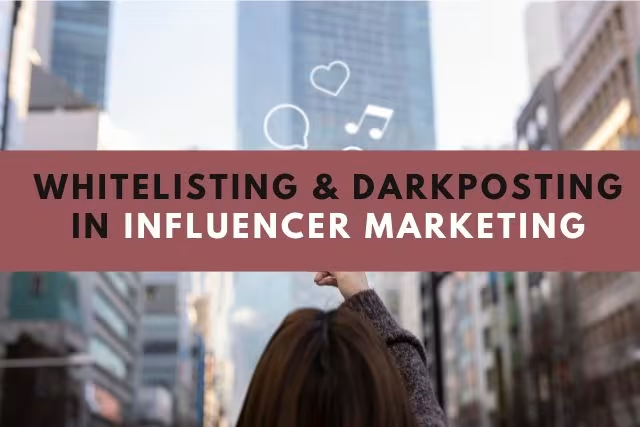Influencer marketing has evolved beyond simple sponsored posts. Today, strategies like whitelisting and darkposting in influencer marketing are gaining popularity among brands and creators. These tactics allow businesses to reach highly targeted audiences, boost conversions, and measure campaign success more effectively. But what exactly do these terms mean, and how do they differ? Let’s break it down.
Unlike traditional influencer posts that rely mainly on organic reach and engagement, whitelisting and darkposting bring a performance marketing angle to influencer campaigns. They allow brands to combine the authenticity of influencer content with the precision of paid advertising. This means businesses are no longer limited to the influencer’s follower base—they can target new, highly specific audiences, retarget past visitors, and optimize content for conversions while still leveraging the influencer’s credibility.
What is Whitelisting and Darkposting in Influencer Marketing?
Whitelisting and darkposting are advanced influencer marketing strategies where brands leverage influencer content in paid advertising campaigns. Instead of relying only on organic reach, these methods allow marketers to amplify influencer content using precise audience targeting.
- Whitelisting involves brands gaining access to an influencer’s social media account permissions to run ads through the influencer’s handle.
- Darkposting refers to creating paid ads that don’t appear on the influencer’s main feed but are shown directly to targeted audiences.
Both methods help brands maximize ROI, improve targeting, and scale influencer-driven content effectively.
What is Whitelisting in Influencer Marketing?
Whitelisting in influencer marketing means that influencers give brands permission to use their social media profiles for running paid ads. These ads look like they are posted directly from the influencer’s account, but the brand controls the targeting, spend, and campaign objectives.
Benefits of Whitelisting in Influencer Marketing:
- Increased trust since ads come from the influencer’s handle.
- Better engagement rates compared to brand-only ads.
- Access to influencer audiences plus additional targeted reach.
- Ability to optimize ad performance with A/B testing.
What is Darkposting in Influencer Marketing?
Darkposting in influencer marketing is when brands create and promote influencer content as ads that don’t appear on the influencer’s timeline or feed. Instead, they show up only in the targeted audience’s feed as a “sponsored post.”
Benefits of Darkposting in Influencer Marketing:
- Clean influencer profiles without excessive ads.
- Highly targeted campaigns for specific audience segments.
- Flexibility to test multiple creatives without cluttering feeds.
- Better control over message customization.
Whitelisting vs. Darkposting in Influencer Marketing
Here’s a quick comparison to understand the differences:
| Aspect | Whitelisting | Darkposting |
| Visibility | Ads appear under influencer’s handle | Ads don’t appear on influencer’s profile |
| Control | Brand manages targeting & spend | Brand controls targeting & creative fully |
| Audience Impact | Uses influencer’s credibility | Uses influencer’s content without feed clutter |
| Best For | Building trust & reach | Running targeted, test-heavy campaigns |
When Should Brands Use Whitelisting or Darkposting?
Choosing between whitelisting and darkposting in influencer marketing depends largely on the brand’s objectives, campaign type, and target audience.
Use Whitelisting when credibility and authenticity are the top priorities. Since the ads run directly through the influencer’s account, followers perceive them as more genuine and trustworthy. This approach works especially well in industries like fashion, lifestyle, beauty, and fitness, where purchase decisions are heavily influenced by brand trust and social proof. For example, a skincare brand collaborating with a well-known beauty influencer can use whitelisting to tap into the influencer’s loyal audience while extending reach through paid ads.
Use Darkposting when the goal is scalability, experimentation, and precision targeting. Brands can create multiple ad variations, test different creatives, and target niche segments without overcrowding the influencer’s main feed. This method is ideal for tech brands, e-commerce platforms, or product launches where A/B testing and clean influencer pages are crucial. For instance, a startup launching a new app can darkpost influencer content to test various messages before scaling the best-performing ad.
Many times, a digital marketing company creates content strategies that combine both methods. Whitelisting ensures authenticity and trust, while darkposting allows for data-driven testing and detailed audience targeting.
Combine Both Strategies for maximum impact.
Many leading brands mix whitelisting and darkposting to balance authenticity with performance. Whitelisting ensures audience trust, while darkposting allows for fine-tuned targeting and creative testing. Together, they create a comprehensive influencer marketing strategy that improves engagement, reach, and ROI.
Frequently Asked Questions (FAQ’s)
1. What is whitelisting in influencer marketing?
Whitelisting is when an influencer gives a brand access to their social account permissions so the brand can run ads through the influencer’s handle.
2. What is darkposting in influencer marketing?
Darkposting refers to paid ads using influencer content that don’t appear on their feed but are shown to targeted users as sponsored posts.
3. Which is better: whitelisting or darkposting?
Neither is strictly better—it depends on campaign goals. Whitelisting builds trust and reach, while darkposting helps with targeted testing and feed management.
4. Can a brand use both strategies together?
Yes. Many successful influencer marketing campaigns use a mix of whitelisting for trust and darkposting for targeted scaling.
5. Why are these strategies important?
Because they help brands go beyond organic influencer reach, offering better ROI, data insights, and audience targeting.


